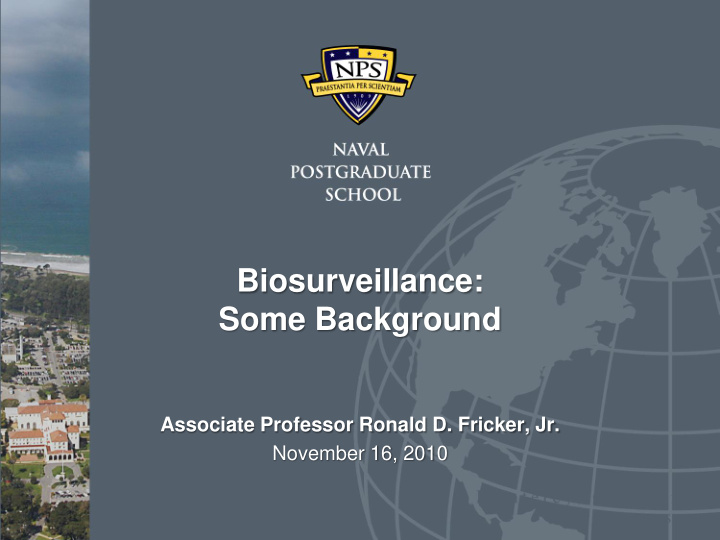



Biosurveillance: Some Background Associate Professor Ronald D. Fricker, Jr. November 16, 2010
What is Biosurveillance? • Homeland Security Presidential Directive HSPD-21 (October 18, 2007) – “The term „biosurveillance‟ means the process of active data- gathering … of biosphere data … in order to achieve early warning of health threats, early detection of health events, and overall situational awareness of disease activity.” [1] – “The Secretary of Health and Human Services shall establish an operational national epidemiologic surveillance system for human health...” [1] • Syndromic surveillance – “…surveillance using health-related data that precede diagnosis and signal a sufficient probability of a case or an outbreak to warrant further public health response .” [2] [1] www.whitehouse.gov/news/releases/2007/10/20071018-10.html [2] CDC (www.cdc.gov/epo/dphsi/syndromic.htm, accessed 5/29/07) 2
Idea of Biosurveillance: Leverage Secondary Health Data 3
Purpose: Early Event Detection and Health Situational Awareness • “ Early Event Detection (EED) is the ability to detect at the earliest possible time events that may signal a public health emergency. EED is comprised of case and suspect case reporting along with statistical analysis of health- related data.” [1] • “ Health Situational Awareness is the ability to utilize detailed, real-time health data to confirm, refute and to provide an effective response to the existence of an outbreak. It also is used to monitor an outbreak‟s magnitude, geography, rate of change and life cycle.” [1] [1] CDC (http://www.cdc.gov/BioSense/publichealth.htm, accessed 10/11/08) 4
Existing Biosurveillance Systems • BioSense developed by the CDC • Early Aberration Reporting System (EARS) developed by the CDC • Electronic Surveillance System for the Early Notification of Community-Based Epidemics (ESSENCE) developed by the Department of Defense • Real-time Outbreak Detection System (RODS) developed by the University of Pittsburgh • Google Flu Trends developed by Google 5
Biosurveillance Use Widespread • In 2007-2008, Buehler et al. surveyed public health officials in 59 state, territorial, and large local jurisdictions – 52 responded (88% response rate), representing areas comprising 94% of US population – 83% reported conducting syndromic surveillance for a median of 3 years – ER data most commonly used (84%), followed by: • Outpatient clinic visits (49%) • OTC medication sales (44%) • Calls to poison control centers (37%) • School absenteeism (37%) – Two- thirds said they are “highly” or “somewhat” likely to expand use of biosurveillance in next 2 years 6 Buehler, J.W., et al., (2008). Syndromic Surveillance Practice in the United States: Findings from a Survey of State, Territorial, and Selected Local Health Departments, Advances in Disease Surveillance , 6 , 1-20.
Today’s Briefings • Completed – LT Katie Hagen: Assessing the Effectiveness of the Early Aberration Reporting System (EARS) with Application to Bioterrorism • In-progress – LCDR Manny Ganuza: Assessing the Effectiveness of Cumulative Sum Poisson- and Normal-based Tests for Detecting Rare Diseases – LT Jay Dao: Assessing the Effectiveness of Biosurveillance via Discrete Event Simulation – LT Randi Korman: Assessing the ESSENCE Biosurveillance System as Used by the Navy and Marine Corps: User Training, System Employment, and Perceived Value 7
Contact Information • Associate professor, Naval Postgraduate School, Monterey, CA • Contact information – Phone: 831-656-3048 – E-mail: rdfricker@nps.edu – My NPS website: http://faculty.nps.edu/rdfricke/ • Reference material: – Students & theses: http://faculty.nps.edu/rdfricke/frickerth.htm – Papers: http://faculty.nps.edu/rdfricke/frickerpa.htm – Presentations: http://faculty.nps.edu/rdfricke/frickerpr.htm – Text and associated course: http://faculty.nps.edu/rdfricke/Biosurveillance.htm 8
The New Status Quo? 9
Recommend
More recommend